Why Is Food Safety Important In Healthcare? Healthcare Leaders Guide
Learn challenges healthcare foodservice teams face today and key food safety practices to protect vulnerable patients. Get a free healthcare leader...
A cloud kitchen is a shared commercial kitchen space for businesses that mainly focus on preparing foods for delivery or takeout only.
Food delivery services have become increasingly popular in recent times, especially after the effects of the global pandemic. The best example of innovations related to food deliveries is the rise of cloud kitchens. The cloud kitchen concept is not novel but has been improved since its launch in India in 2011.
Its popularity among business owners significantly comes from the concept's lower overhead cost and very high returns. The global cloud kitchen market gathered around $57 billion in 2021, $63.9 billion in 2022, and 65.49 Billion in 2023.
And market growth is expected to increase over the next decade. The latest research estimates the global cloud kitchen market size will reach $185.49 Billion by 2033.
With this much projected growth, it's no wonder cloud kitchens popping up everywhere.
WHAT WE'LL COVER:
In this section, we discuss what cloud kitchens are and the following topics:
A cloud kitchen is a commercial cooking facility where different restaurant brands that are designed for delivery only can simultaneously work or collaborate. They are otherwise known as virtual kitchens, ghost kitchens, shadow kitchens, or dark kitchens.
The cloud kitchen concept uses a commercial kitchen layout that allows cloud kitchen operators to prepare and deliver food without the need for a physical restaurant or dining space.
The cloud kitchen concept basically removes front-of-the-house operations for a business that involves dining service. Cloud kitchens work with the help of food aggregator apps or food delivery apps where the orders are received and collected. Similar to a traditional restaurant, a cloud kitchen works on an order basis. The food is prepared, packed, and delivered to the ordering customer with the help of a delivery service provider.
Customers can order online directly from the kitchen system or through delivery apps, and the cloud kitchen will prepare, package, and deliver the product. Delivery is either done through in-house logistics or a third-party service.
A typical cloud kitchen is equipped with industrial cooking equipment that can cater to large batches of food production. This type of kitchen can have multiple yet similar spaces for creating products with the same process or highly diverse kitchen sections.
The concept of using cloud kitchens opens more possibilities for food business owners. It allows aspiring business owners to reduce overhead costs by removing expenses from establishing a physical dining space. A huge part of the yearly profit normally goes into maintaining the storefront and managing customers.
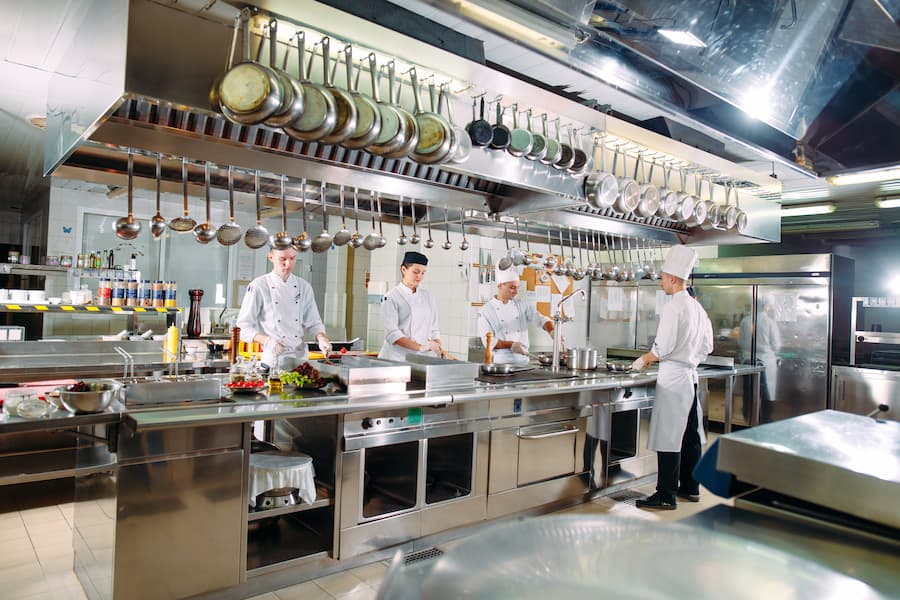
A ghost kitchen is a type of restaurant that focuses on preparing dishes for delivery, whereas a cloud kitchen is a shared commercial facility that accommodates multiple restaurant brands to produce their products.
While ghost and cloud kitchens have a lot in common, they have very subtle differences.
Below are more specific differences between the two terms:
A ghost kitchen is one type of restaurant concept that exclusively focuses on the online delivery of food.
Ghost kitchens mainly operate without a dining section. The establishment is delivery-only, and all of its facility is dedicated to preparing food products. It is sometimes referred to as a virtual restaurant.
A ghost kitchen normally operates under one management and brand. It can be owned by a traditional restaurant and act as an extension of the main facility.

On the other hand, a cloud kitchen is a type of shared kitchen space that can accommodate different restaurant brands at once. Similar to a ghost kitchen, a cloud kitchen only operates for food deliveries. The difference is that multiple brands of the same or different companies can operate in a cloud kitchen.
Cloud kitchens are normally used by restaurant brands as a solution to expanding their delivery reach. This solution will not add to the high overhead costs associated with opening a branch of a traditional dine-in restaurant.
Both cloud and ghost kitchens have their own advantages. Their suitability will depend on the needs of a restaurant owner. While both types of establishments cater to large-scale food operations without a dining part, cloud kitchens are often used for short-term operations compared to ghost kitchens.
In terms of food safety, both types of kitchens have their own requirements. A cloud kitchen is expected to require stricter rules as different restaurant brands may have completely different operations, which could promote cross-contamination or cross-contact between products.
The main difference between a traditional restaurant and a cloud restaurant is that a traditional restaurant typically has a physical storefront and provides dine-in service, whereas a cloud restaurant operates online and delivery only, without a physical dining area.
The lack of a storefront significantly changes the dynamics of a cloud kitchen. The managing team will have to focus more on things like delivery and marketing.
Here are some key differences between the two types of food businesses:
Physical presence. A traditional restaurant has complete front and back-of-the-house facilities, whereas a cloud kitchen does not have a dining area.
Customer interaction. Cloud restaurants typically rely on online ordering and delivery services, which offer limited customer interaction. On the other hand, traditional restaurants can attract customers through on-site interactions, especially with high foot traffic.
Overhead costs. Traditional restaurants have to spend more for a physical location, equipment, staff, and other expenses associated with maintaining a storefront. Cloud restaurants, on the other hand, have lower overhead costs because of the lack of physical storefronts, which means less service staff for front-of-house operations. This is the most notable advantage of cloud kitchens.
Extensiveness of the menu. Traditional restaurants typically have a more extensive menu with a variety of options for dine-in, takeout, and delivery. In contrast, cloud restaurants offer food dishes that are built for delivery.
Business model. Traditional restaurants can use a combination of dine-in, takeout, and delivery services to generate revenue, whereas cloud restaurants can only do business online and rely on delivery services for revenue.
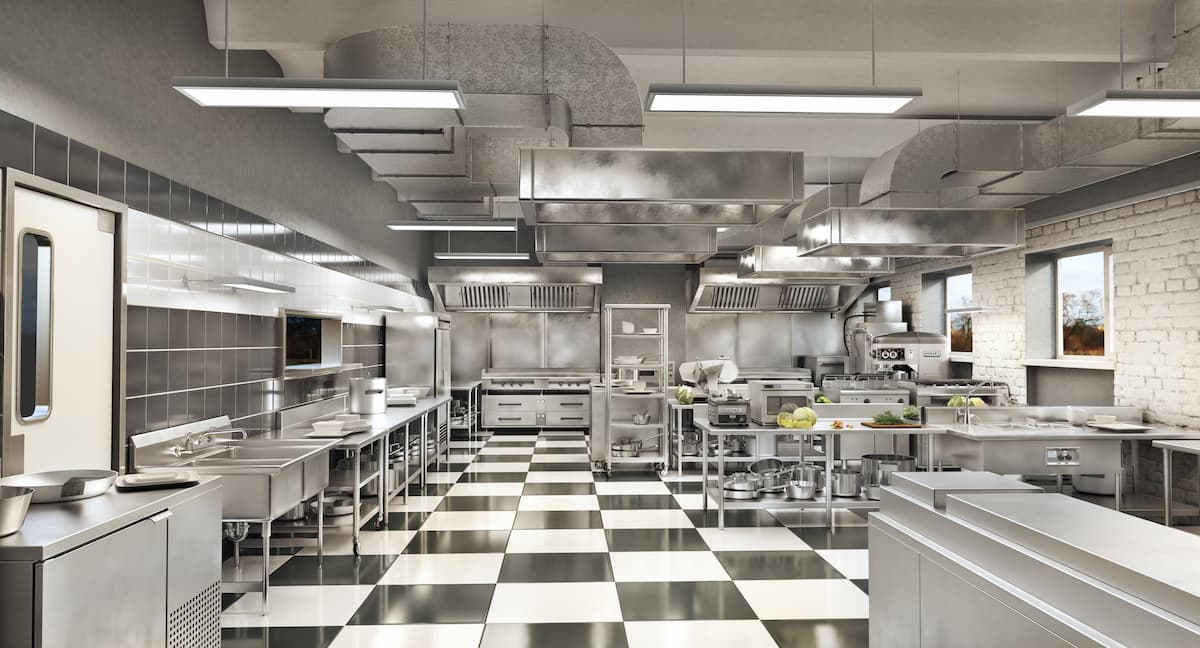
While there are several differences between traditional restaurants and cloud kitchens, the requirement to comply with food safety regulations stays the same. What food business owners need is a food safety management system that can work for both types of food operations.
Use FoodDocs' digital Food Safety Management System to maintain compliance with all food safety regulations for your business. With our smart software, you can get a quick overview of your entire production status, whether you are operating a traditional or a cloud kitchen. You can save time by managing your team and focusing more on improving other business aspects.
You can use our automatically generated monitoring forms and integrate them with temperature sensors for faster information recording. Make monitoring and food safety compliance more efficient with our digital Food Safety Management System.
A cloud kitchen is often used to aid an existing restaurant business in expanding its operations and reach. Cloud kitchens can help produce more food products and cater to more customers without the need to establish a dining area or hire more staff.
Cloud kitchens help provide efficient and cost-effective ways for restaurants to reach more customers without the need to establish a physical dining space.
Other benefits that come from using cloud kitchens can be used to improve marketing strategies and determine how to serve customers better with better products.
To better understand how a cloud kitchen can help your business grow, we show you the main pros and cons of using this type of food facility below.
Reduced overhead costs. Cloud kitchens do not need to spend on maintaining a dining section. This allows restaurants to allocate more resources toward food quality, marketing, and other business development activities.
More flexible operations. Cloud kitchens allow restaurants more room for creativity in making products. Restaurants will not have to commit to additional facility equipment to accommodate a new product.
Wider reach. By partnering with online food delivery platforms, cloud kitchens can reach a wider customer base than a traditional brick-and-mortar restaurant. In some cases, farther locations of cloud kitchens act as an extension of your main branch. Businesses can start operating in areas where their main branch cannot reach without the need to allocate funds for dining sections.
Efficient operations. Cloud kitchens are designed for operational efficiency and streamlined processes for order fulfillment. Cloud kitchens also make monitoring easier as everything is organized in a predetermined flow.
Data insights. Online solutions that go with cloud kitchens can gather valuable data on customer behavior, ordering patterns, and feedback. This information can be used to tailor services and menu offerings to consumer demands with a more data-driven approach.
While there are several benefits to operating a cloud kitchen, restaurant operators must also consider the drawbacks. The profit margin that may be generated as a result of fewer storefront operations may be significantly redirected to marketing strategies. Optimizing the benefits of cloud kitchens will significantly depend on how business owners use these benefits to their advantage.
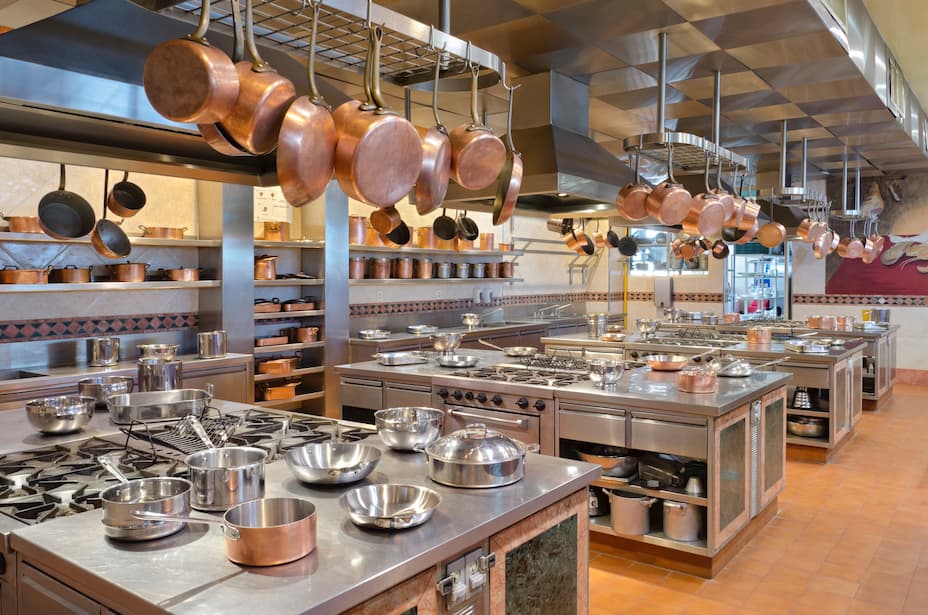
Several types of cloud kitchens exist, each with its own unique characteristics and cloud kitchen business models. The types of cloud kitchens have diversified over the years, and each one has its own requirements and strengths.
Here are some of the most common types of cloud kitchens:
Independent cloud kitchens. Independent cloud kitchens are not affiliated with any specific restaurant or food brand. The management is solely focused on cloud kitchen services. This type of management typically offers shared kitchen space for rent to multiple independent food businesses.
Multi-brand cloud kitchens. Some cloud kitchens are owned and operated by a single company or organization and host multiple affiliated food brands under an establishment. Every food brand has its own operation, but they can share facilities and ingredients or collaborate with each other.
Franchise cloud kitchens. These are cloud kitchens that are part of a larger franchise network. This type of cloud kitchen basically specializes in the operations of a particular food business. Franchisees can use the franchisor's branding and operational support to launch their own virtual restaurant concepts.
Choosing which cloud kitchen type best suits your needs will depend on the goals of a food business. The success of the cloud kitchen will also depend on how well the operations are being managed and their compliance with applicable regulations.
If you are just starting a cloud kitchen business, allow FoodDocs digital Food Safety Management System to cover your food safety compliance part. You can get HACCP Plan done in 1 hour and start monitoring food safety checks in 15 minutes.
Our system (which comes with a 14-day free trial) can automatically generate monitoring logs equipped with detailed instructions on how to perform tasks accurately. Pair this feature with our smart notification system that alerts food handlers whenever a task is due. The notification system ensures that no task is ever forgotten.
The pricing model for cloud kitchens can vary depending on the specific business model and target market. The allowed operations inside the kitchen can determine the pricing. Business owners who are looking into using a cloud kitchen must carefully assess which pricing model is best for consistent growth.
Here are a few examples of pricing models that are commonly used:
Flat fee. Some cloud kitchens can charge flat rates for renting kitchen brands. This means that there is a fixed monthly fee that must be paid regardless of well a brand works. This model is more suitable for food businesses that have a predictable daily order volume or those that have a clear forecast of their sales.
Revenue sharing. In this model, a business pays the cloud kitchen management on a commission basis. The cloud kitchen's rental fee will be determined by the number of products a brand sells. This pricing model may be more suitable for smaller or emerging restaurant brands that have less predictable sales volumes.
Membership model. Some cloud kitchens offer a membership payment basis. In this model, restaurant brands are required to pay a monthly or annual fee for renting commercial space. This pricing model may be more suitable for restaurant brands that have ongoing kitchen space needs and require additional support services.
Commercial kitchen pricing models may include charges for provided marketing tools, additional equipment requests, delivery, and other services.
Choosing the most suitable pricing model will significantly affect your net revenues. On a business aspect, brand owners must carefully consider if their business will survive with the suggested pricing model.
The startup cost of a cloud kitchen can vary greatly depending on a number of factors. On average, business owners can establish a working cloud kitchen at an average minimum cost of $13,000. This estimated capital investment can increase or decrease depending on the location of the kitchen, its size, the equipment offered, and its services.
Here are some of the main cost considerations for starting a cloud kitchen:
Rent and utilities. Normally, a bigger space will require higher rental fees. Business brands must consider if the cost can be reduced when the number of working brands increases. Additionally, fixed utility costs such as electricity, water, and gas must be considered.
Equipment. Cloud kitchens require specialized equipment such as ovens, grills, refrigerators, and prep stations. Basically, the more extensive your list of equipment is, the more desirable your kitchen will be to different brands.
Technology. Cloud kitchens rely heavily on technology for online ordering, payment processing, food safety monitoring, and delivery logistics. This may require investment in software, hardware, and integration with third-party platforms.
Labor. A cloud kitchen still requires a long list of staff that will operate the facility. Your staff will include chefs, food handlers, and cleaning personnel. The kitchen will also need an order manager to facilitate online food delivery orders and delivery personnel.
Marketing and branding. A huge part of the capital will also be invested in marketing. Especially for a business that does not have a physical dining presence, customers can only hear about your operations through online platforms. Marketing and branding costs may include website development, social media advertising, and other promotional activities.
Overall, the cost of starting a cloud kitchen can range from tens of thousands to hundreds of thousands of dollars, depending on the factors mentioned above. In comparison with opening a restaurant, the minimal cost required for opening a cloud kitchen is significantly less. It is important to carefully consider all costs and create a detailed budget before starting a cloud kitchen.
Cloud kitchens are as advanced as it gets in the restaurant industry. As a business owner, taking advantage of the technologically advanced operations of cloud kitchens can significantly improve your business.
A good investment in technology is to use a digital Food Safety Management System. At FoodDocs, our smart software can cover both managing food safety and establishing a traceability system. Cloud kitchens can efficiently monitor the flow of their products until they are delivered while ensuring that all of them will not cause foodborne illnesses.

Industry reports state that profit margins for cloud kitchens can range from 10% to 30%. Cloud kitchens are estimated to reach a global industry value of $1 trillion by 2030.
The very high-profit margin of cloud kitchens comes from the lack of additional overhead costs for establishing, running, and maintaining a physical storefront. Most of the costs of running a cloud kitchen go into space rental, purchasing equipment, maintenance, and back-of-the-house staff.
Cloud kitchen's profit margins can be optimized by using the appropriate marketing strategies and using the full extent of technology. These operations must be consistently monitored and maintained to ensure the success of a cloud kitchen.
In this section, we explain the basic steps to start a cloud kitchen and other essential considerations, such as the following:
Cloud kitchens may have significantly different dynamics when it comes to management, but the process of starting one is almost the same as a traditional restaurant.
Here are some key steps to consider when starting a cloud kitchen:
A food delivery market analysis will help you determine which areas have higher online traffic and demand for deliveries. This information can help you figure out the most effective location and products for your business.
Outline the target market, menu, pricing strategy, marketing plan, and financial projections. Use this information to produce a sound strategy for promoting the business.
The importance of this component cannot be stressed enough. Choose a space that meets your needs in terms of size, equipment, and location. If you are still testing the market for cloud kitchens, you can consider leasing a space.
Secure food handler permits, health department permits, and business licenses. Permits that are needed for on-site dinings, such as alcohol permits, are no longer needed for cloud kitchens.
Secure a supplier that can consistently provide high-quality ingredients at the rate of your requirement.
The staff for your kitchen operations will mainly consist of chefs, kitchen staff, and delivery drivers.
You can either partner with third-party services or establish your own delivery system.
Before opening your cloud kitchen, make sure that your business has established a comprehensive food safety plan. This document will help you ensure that your products will not cause foodborne illnesses to the consumers.
Promote your cloud kitchen through online platforms and bring in traffic to your website. Invest in online systems that will help you boost your visibility online.
Perform regular checkups and verifications on your operations. Revise any inefficient task that may be reducing your productivity.
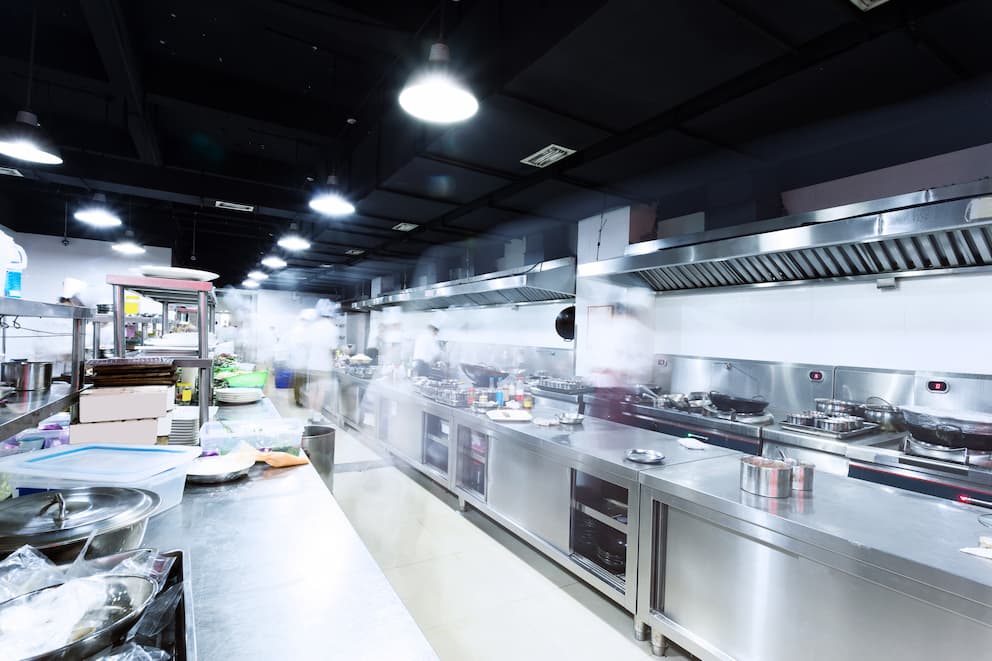
The benefits of running a cloud kitchen can only be achieved if the business is well-equipped and prepared. Ensure that you have secured all necessary permits and licenses and that your staff is well-trained in operating a cloud kitchen.
You can also add safety precautions in your kitchen facility to promote proper food handling. Use our free Food Safety Posters to ensure that every food handling procedure is done according to regulations.
Establish your food safety plan using FoodDocs digital HACCP plan builder. With our digital solution, you can get a comprehensive digital HACCP food safety plan in just 1 hour. Ensure that your operations are equipped with the essential critical control points to prevent any potential food safety problems.
Using artificial intelligence and a machine-learning program, our system can automatically generate the essential components of your food safety plan. Customize each section and tailor them to fit your business easily.
A cloud kitchen's location can determine its operational cost, customer traffic, and proximity to suppliers. Your establishment's location is a critical factor in your success.
Here are some factors to consider when selecting a location:
Market demand. Choose an area with high food delivery demand from potential customers. The community in this area must be very familiar with the food delivery concept. Choose high-income residences and populated areas.
Accessibility. While online customers do not need to go to your business store, your kitchen's accessibility will determine the cost of delivery. The location should be easily accessible to customers, delivery drivers, and suppliers for a timely delivery. This factor includes the level of development in terms of highways and roads for efficient logistics.
Infrastructure. Check the location's access to essential utilities such as water, electricity, and gas. Consult with local health inspectors for any specific requirements when building your kitchen.
Cost. Different locations have different operational costs. Consider the cost per square foot, deposit requirements, and any additional fees for utilities, maintenance, and cleaning services.
Zoning and permits. Some locations are not fit for a cloud kitchen due to their neighboring businesses. Consult local zoning departments and ensure that the location is zoned for commercial food preparation.
Competition. A few competing cloud kitchens can be healthy to sustain the demand. Make sure that your chosen location is not yet saturated and can still accommodate your cloud kitchen.
Future growth opportunities. When choosing a location, always consider the possibilities of expanding your business. Check if the location can accommodate more space for expansion.
These factors are just some of the critical considerations when choosing the right location. Business owners must also be familiar with the market or consumer behavior and learn how to project trends and potential changes in time.
Different cloud kitchens have their own specialization. Some may mainly accommodate baked-type goods, whereas others can specialize in cooked dishes.
The projected cuisines or types of dishes that will be produced in the cloud kitchen will determine the needed equipment and facility.
However, here is a list of essential equipment that most or any type of cloud kitchen will require:
Commercial-grade cooking equipment. This includes commercial stoves, ovens, griddles, fryers, and other cooking equipment specific to your menu items that can accommodate large-scale preparations.
Refrigeration equipment. Regardless of the type of dishes you will be preparing, walk-in coolers and freezers, reach-in refrigerators, and freezers are required.
Dishwashing equipment. This includes dishwashers, three-compartment sinks, and cleaning supplies, such as brushes, cloths, soaps, and sanitizers.
Storage and shelving. This includes shelves and rooms dedicated to storing equipment, utensils, and ingredients.
Prep and cooking utensils. Cutleries, cutting boards, knives, mixing bowls, spatulas, measuring cups, and other utensils are necessary for food preparation.
POS system. A point-of-sale (POS) system for processing orders, tracking sales, and managing inventory. This component is mandatory for cloud kitchens. Unlike traditional restaurants, a POS system is the only way for customers to pay and contact your business.
Fire suppression system. This includes fire suppression tools that meet local safety codes and regulations.
HVAC system. A heating, ventilation, and air conditioning (HVAC) system that meets local regulations and provides proper air circulation.
Safety equipment.First aid kits, safety signs, and other safety equipment to ensure a safe working environment.
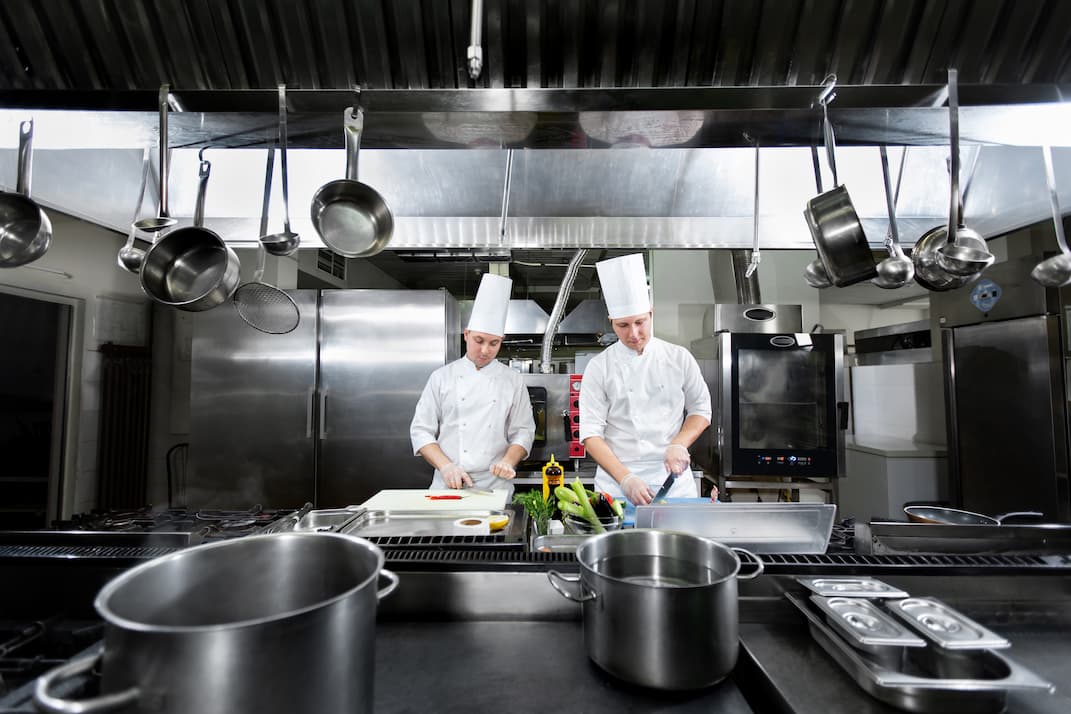
Other more specific equipment, tools, and machines may be essential for your cloud kitchen, depending on your target operations. Your cloud kitchen staff can also significantly benefit from visual aids, such as Kitchen Posters, that will guide them with basic food safety operations.
Basically, all equipment, machines, and tools for a cloud kitchen must be commercial-grade to accommodate large-scale productions.
This list is a basic enumeration of critical equipment and tools for a cloud kitchen. Operations can be further optimized by adopting other solutions, such as smart software.
There are several examples of cloud kitchens that are currently operating around the world. Some examples include:
Kitchen United. Kitchen United is a cloud kitchen company based in the United States with multiple locations. They provide kitchen space and services to a variety of virtual restaurant brands, including well-known chains such as Chick-fil-A and Panera Bread.
Deliveroo Editions. Deliveroo Editions is a cloud kitchen platform that operates in several countries, including the United Kingdom, Australia, and the United Arab Emirates. They provide kitchen space and support services to independent virtual brands of restaurants.
These are just a few examples of the many cloud kitchen companies that are currently operating in the U.S. and U.K., offering a range of cuisine options and delivery services.
Cloud kitchens are not exempted from following food safety regulations. In fact, their compliance is highly concentrated in food preparation practices which are the core operations that are commonly involved in food safety issues.
Here are some key steps you can take to ensure food safety in a cloud kitchen:
Establish a HACCP food safety plan. A comprehensive food safety plan is your best defense against food safety issues, and it ensures that your business runs in compliance with the applicable regulations. Ensure that your food safety plan is based on the highest standards, such as a HACCP plan. Create control points for handling food, cleaning, storage, and transportation. Extra steps must be established for cloud kitchen's delivery services.
Train staff on food safety protocols. Training is a must, and it is the responsibility of a food safety manager to provide training to their employees. All kitchen staff must be knowledgeable about the 4 C's of food safety handling, proper hygiene, foodborne illnesses, sanitation, and food regulations. In addition, implementing a food safety culture is a part of training food staff.
Use high-quality ingredients. Food safety starts with the quality of the raw materials that you are using. Secure a supplier that can provide fresh raw ingredients in bulk while maintaining the same level of food safety as your business.
Regularly monitor temperature control. Implement monitoring procedures and logs for maintaining the correct temperatures of refrigerated storage, cooking, the environment, and delivery to prevent the unnecessary growth of pathogenic microorganisms. Logging temperature is a critical documentation process as proof of food safety compliance. You can intuitively do this task using FoodDocs' smart monitoring logs equipped with a prefilling solution.
Conduct regular health inspections. Regularly inspect your kitchen for any potential food safety hazards, such as pests or equipment malfunctions. Schedule routine maintenance and cleaning to prevent potential problems.
Implement quality control procedures. Establish quality control procedures to ensure that food is prepared and stored correctly. Use labels and date codes to track the freshness of food and discard any expired or contaminated items.
Implement a food recall plan. Ensure that your business has a working traceability system and a recall plan. In case of food safety issues, these systems will help you minimize potential damages by easily tracking your products off the market. Get a digital Product Recall Log as part of our smart solutions in our digital Food Safety Monitoring System.
Use food safety technology. Use digital solutions, such as temperature monitoring systems and food safety apps, to help track and monitor food safety practices in the kitchen.
Like any other food business, food safety is a critical element for running a cloud kitchen. The only difference is that food safety for cloud kitchens focuses on back-of-the-house operations and delivery services. This means that monitoring operations are more concentrated on food preparation, cooking, storage, and delivery, without the need to monitor food service.
Everything that any cloud kitchen needs for food safety management is covered by FoodDocs' smart solutions. When starting a cloud kitchen, your first requirement for food safety compliance is to create a comprehensive food safety plan.
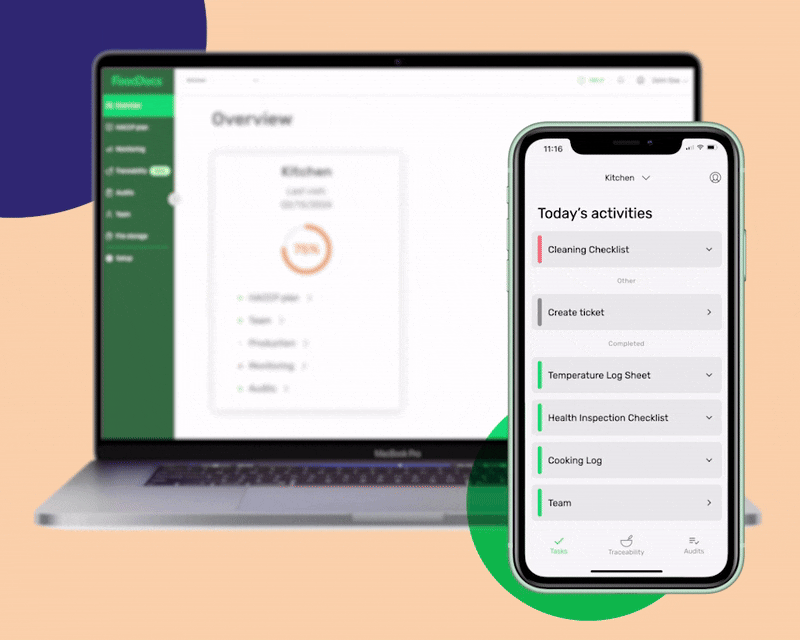
With FoodDocs digital HACCP plan builder, you can automatically get a comprehensive food safety plan based on the gold standard of management systems. Using artificial intelligence, our system can automatically generate a comprehensive HACCP plan template complete with all the essential components of a HACCP plan.
.png?width=1065&height=924&name=HACCP_template%20(1).png)
All components of your generated digital HACCP plan are completely customizable. So, you can apply any revisions or suggestions from inspectors or your team members easily. Complete your food safety compliance requirements in an average of 1 hour with our smart solution.
Once you achieve compliance, the next step is to maintain it with consistent monitoring. Through our HACCP-based digital Food Safety Management System, you can get the essential tools to intuitively and efficiently monitor your everyday food safety operations.
Using the information that you will provide to our system, you can automatically get a comprehensive digital Food Safety Management System that is based on your operations. Some of the most useful tools and benefits that every cloud kitchen can get from our system include the following:
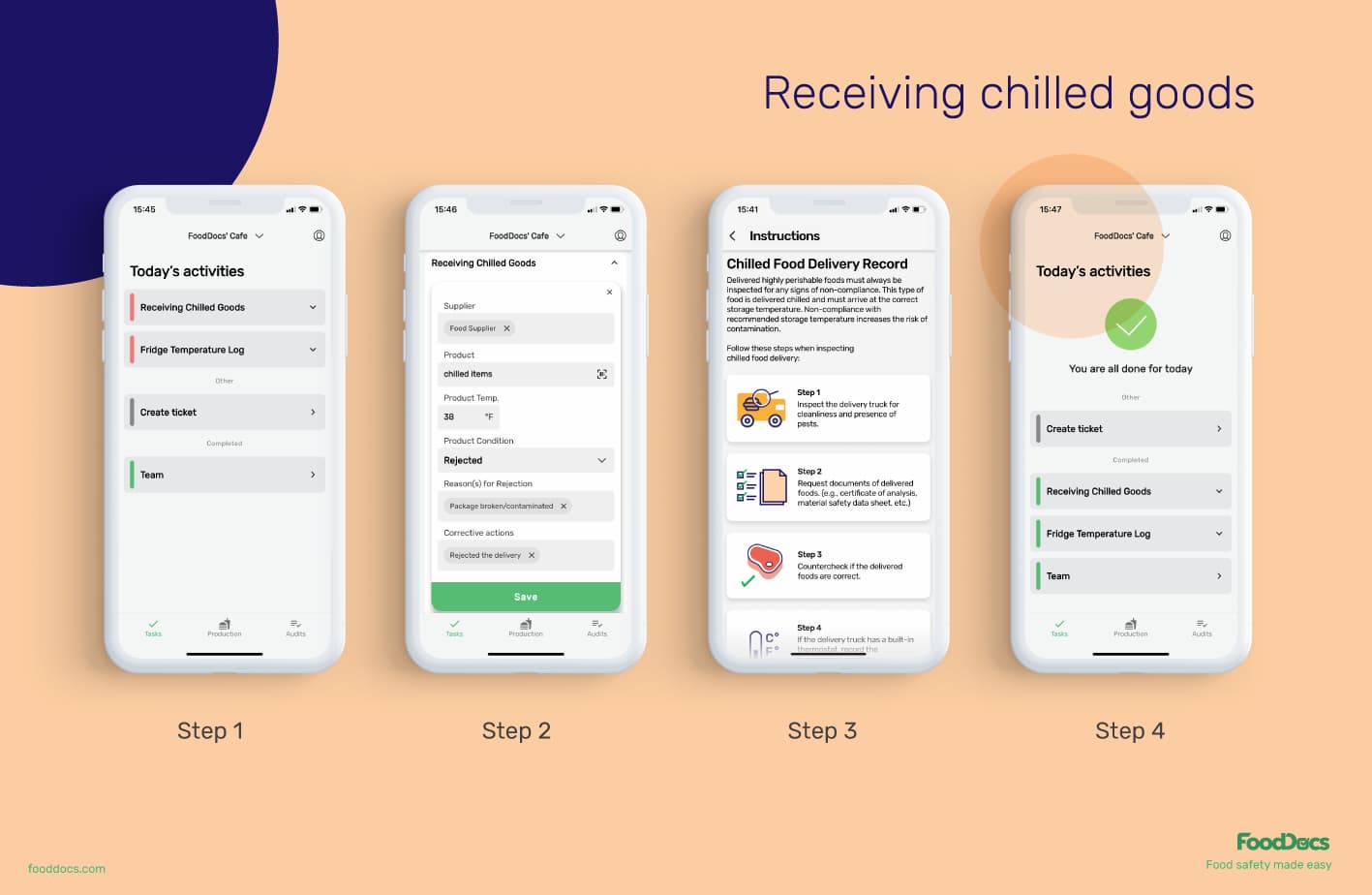
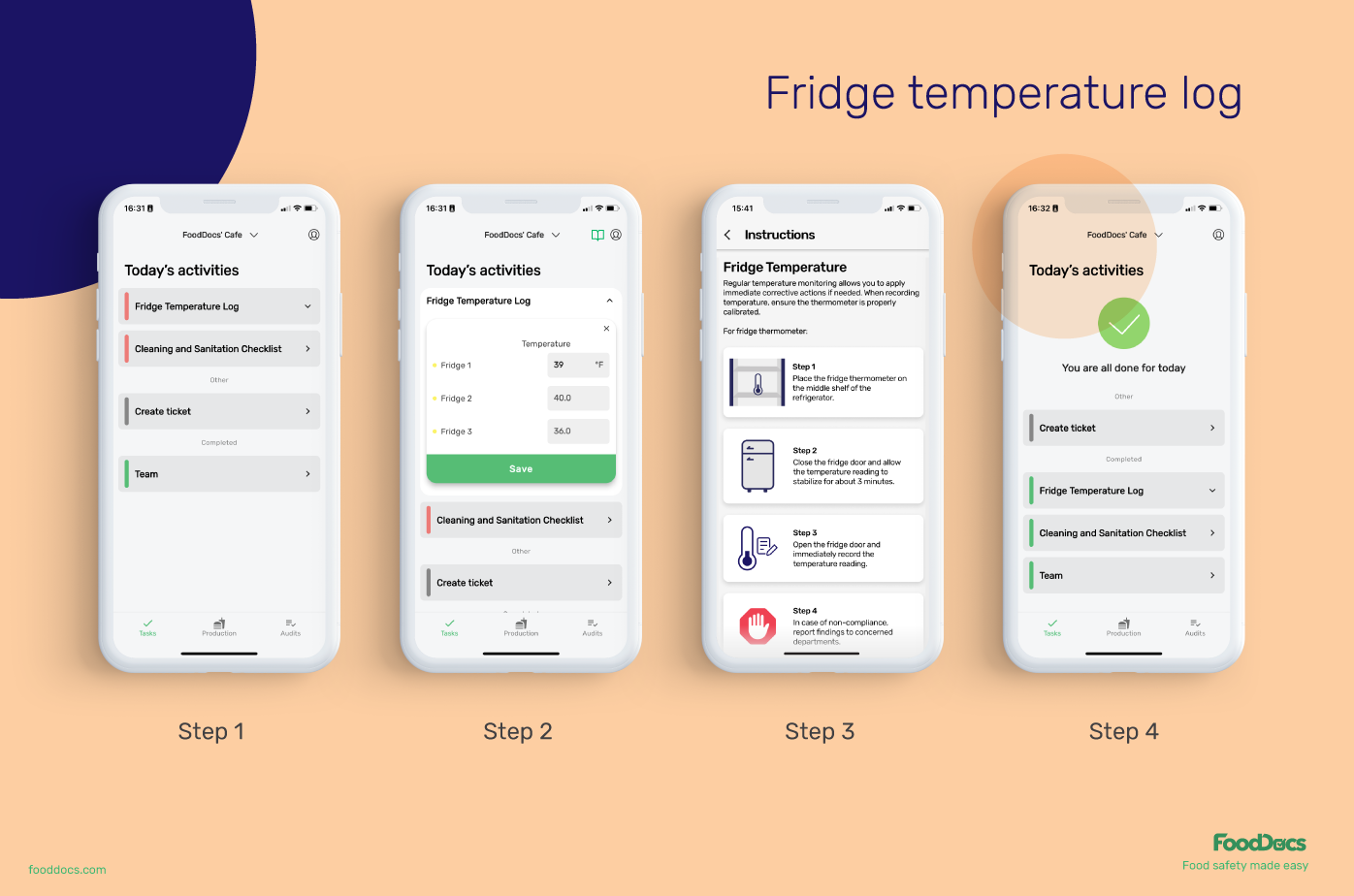
All generated logs are equipped with detailed instructions to help food handlers perform the operations correctly and a prefilling solution. The logs can be automatically filled based on previously inserted data, saving your employee's time and increasing data accuracy. All that is left to do is to verify the information.
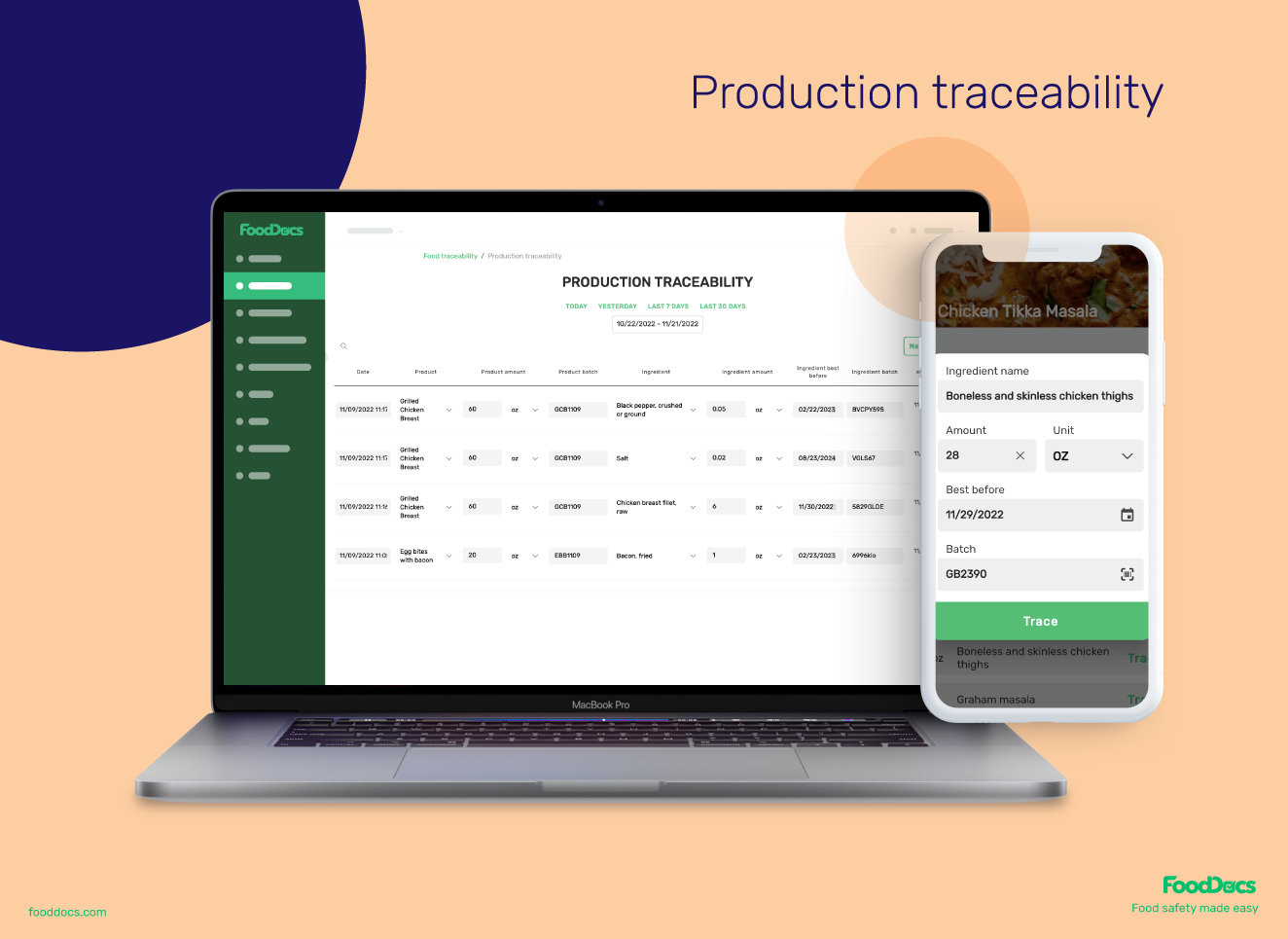
In addition to food safety operation solutions, our digital Food Safety Management System Software can also help managers supervise their operations remotely.
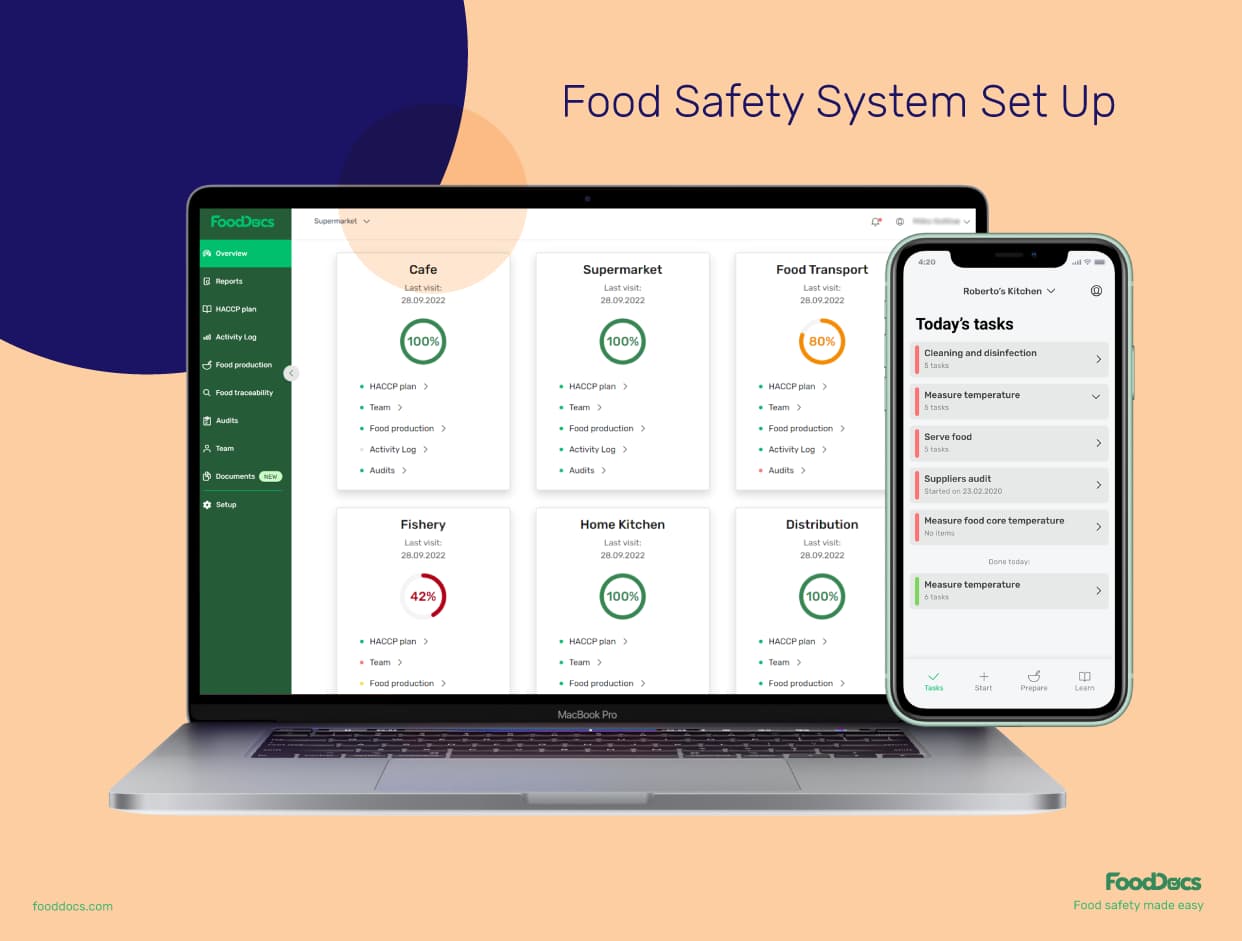
Our digital platform is the best food safety solution for cloud kitchens. This type of food business fully depends on online solutions. Our system can be integrated with other digital services and can work seamlessly to streamline cloud kitchen operations.
All digital documents generated by our software can be further customized and improved according to your needs. Ensure the success of your cloud kitchen operations by maintaining food safety compliance in every dish that you send out from your kitchen.
Experience our services for free and establish your food safety management system in just a few minutes using our free 14-day trial now.
Here are some of the most common questions asked about cloud kitchens:
A cloud kitchen is a food business that uses a commercially shared kitchen space for different brands that serve customers through delivery-only modes. This type of establishment does not have a physical storefront where customers can dine in. Consumers will typically place an order through an online order app, and the food will be prepared and delivered according to the order.
Cloud kitchens offer an avenue for restaurants to expand their business to farther locations without having to spend too much for a big facility. The concept provides an opportunity for restaurant owners to reach more customers, explore new markets, and increase their production capacity.
Starting a cloud kitchen is estimated to cost an average minimum of $13,000. This estimate can go up or down depending on the scale of the kitchen, the intended operations and kitchen equipment, the location, and other business factors.
Choosing the prime location is everything for a cloud kitchen. Choose a densely populated area where people are accustomed to ordering food rather than dining in for service. Also, consider the location's proximity to nearby suppliers and accessibility to logistics operators.
Cloud kitchens work entirely on online platforms. Select marketing modes that will help boost your online presence for brand recognition. Make sure that your website has all of the necessary information for your customers and optimize data gathering information from your partner companies.
The best way to ensure food safety in a cloud kitchen is to implement a digital food safety management system. Since cloud kitchens run entirely on online ordering, a digital food safety system will also help streamline your monitoring processes, making them more efficient and secure.
Typically, restaurant brands that go well with food deliveries opt for opening cloud kitchens. Unlike a traditional kitchen and restaurant, cloud kitchens cannot add the appeal of dining in a good setting. As such, restaurant brands with products that can withstand delivery are more suitable for cloud kitchen operations.
Most cloud kitchens partner with third-party delivery services or food aggregators to handle their food deliveries. This solution makes it easier to focus on preparing and securing the dishes for delivery.
The cloud kitchen concept is a type of food business that uses a shared commercial-grade kitchen for multiple restaurant brands with no storefront to prepare delivery-only menu items.
Learn challenges healthcare foodservice teams face today and key food safety practices to protect vulnerable patients. Get a free healthcare leader...
Learn what Standard Operating Procedures (SOPs) are and how to write effective SOPs that ensure consistency, efficiency, and safety in your...
Boost your retail food safety with essential practices and digital tools to protect customers and your brand. Plus a free Retail Food Safety Leader...